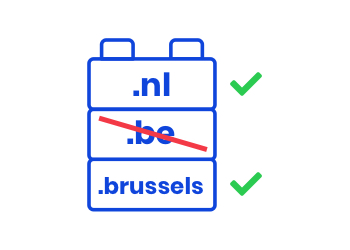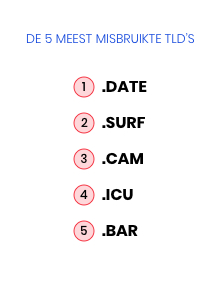A TLD or Top-Level Domain is the rightmost part of a domain name: the domain name extension or domain extension. That is, of course, the shortest possible explanation, but rest assured that there is much more to it than just that. We will gladly provide you with further information about TLDs and their use on the Internet!
What is TLD?

TLD stands for Top-Level Domain. Every domain name has such a Top-Level Domain: it is the last part of the domain name. Let us take a moment to examine such a name:
blog.combell.com
- .com: Top Level Domain
- .combell: Second Level Domain (2LD)
- blog: Third Level Domain (subdomain)

In theory, you could go even further (for example, this.is.my.blog.combell.com), but in practice this rarely happens, as the purpose of the different levels – to create order – would be somewhat lost.
But that gives you a clear idea of where you have ended up: you are on a blog run by Combell, on a website that is aimed at people from all over the world (as indicated by the .com domain name).
A TLD is not only useful for you as a visitor; it also ensures that the Domain Name System (DNS) of the Internet is properly organised. That system ensures that every Internet user arrives at the right place when he or she clicks on a link or enters an address in his or her browser. So, as you can imagine, order and neatness are important if you want to take everyone to the right website.
When you want to register your domain name, you have to choose two things: your name (in this case ‘combell’) and the domain name extension (in this case ‘.com’). Such an extension is usually an abbreviation (just think of .com or .be), but it can also be a whole word, such as .sale or .immo.
In order to register a domain name, you must first check whether your desired name and extension are still available. If your domain is still available, you can register it with a registrar such as Combell.
Remember that a domain name is not a website. If you want to link a website to your domain, you also need to order hosting. Combell offers hosting with 24/7 support provided as a free service.
What domain extensions are there?
If you look at the Internet, you will notice that there are many different domain name extensions. You undoubtedly know .com, .be or .eu domain names. But new extensions are being added all the time.
Three types of domain extensions
- ccTLDs – country-code extensions
- gTLDs – generic extensions
- sTLDs – sponsored extensions
- This subdivision into different types was introduced by IANA (Internet Assigned Numbers Authority), an international organisation responsible for ensuring the smooth running of ‘the Internet’.
Let us briefly examine the three different types separately.
ccTLD
Country Code Top-Level Domains or ccTLDs are the easiest extensions to explain: they indicate countries and consist of at least two letters of the Latin alphabet.
Examples of ccTLDs:
- .be – Belgium
- .nl – The Netherlands
- .de – Germany
- .cn – China
- .us – United States
- .lu – Luxemburg
- .es – Spain
- .tr – Turkey
Countries, however, are not the only ones that can have a ccTLD. For example, there is also a .eu extension for the European Union.
In total, there are (approximately) 312 ccTLDs. For some extensions, you must be a citizen of a certain country to be allowed to register it, but most of them can be purchased by anyone.
As it happens, there are also exceptions to the rule of ‘at least two letters of the Latin alphabet’. Because what about countries that do not use our alphabet? Well, they can create domain names using their own alphabet. The extension for China, for example, is .中国 instead of .cn. This is called an IDN (Internationalised Domain Name).
gccTLD
And it is precisely because everyone is allowed to register most domains with a ccTLD that they are often used because of how good they look. .tv, for instance, is the country code for Tuvalu, but it is often used by – drum roll! – media companies.
This creates a subcategory within the ccTLDs: gccTLDs (generic ccTLDs). These are country codes that are more often used as gTLDs (see below) than as extensions to indicate a particular country.
Examples of gccTLDs:
- fm – Micronesia’s ccTLD, which is more often used by radio stations
- .io – British Indian Ocean Territory’s ccTLD, which is more often used by Internet companies
- .nu – Niue’s ccTLD, which is used by – for example – vrt.nu.
Good to know:
ccTLDs can be deleted when a country ceases to exist. Just think of Zaire (.zr), Czechoslovakia (.cs) or East Timor (.tp): you will no longer find those three extensions, because their corresponding countries no longer exist. But in order to prevent the Internet from being shaken up too much, it is possible for the ccTLD of an ‘ex-country’ to remain in existence. Just consider .su: it still exists, even though the Soviet Union was dissolved 30 years ago!
gTLD
A Generic Top-Level Domain or gTLD does not indicate a geographical domain; it rather focuses on a subject or thematic area. They always consist of at least three letters, unlike ccTLDs.
examples of gTLDs:
- .com
- .net
- .org
- info
- .biz
Most gTLDs are based on a word: .org for organisation, .biz for business or .com for commercial. These extensions were originally intended for commercial organisations. But today, anyone can register a .com extension, just like most other gTLDs.
New gTLDs
Around 2011, ICANN made it possible to register new extensions. And that was a successful move: before 2011, there were only 22 gTLDs, whereas now there are more than 1,500. A list of all currently available extensions can be found on the IANA website.

Examples of new gTLDs:
- .immo
- .pizza
- .contact
- .cool
- .sale
- mom
- democrat
geoTLDs
When we said that gTLDs mainly indicate subjects, we were actually lying a bit, because there are also gTLDs that indicate cities or geographical areas. Those are sometimes called geoTLDs.
Examples of geoTLDs:
- .gent
- .vlaanderen
- .amsterdam
- .nyc
sTLD
sTLDs are sponsored Top Level Domains. In principle, these are gTLDs, but they are sponsored by a specific company or government, and they are exclusive to a particular sector.
Examples of sTLDs:
- .gov – exclusively for the US Government
- .museum – exclusive for museums (sponsored by an international organisation of museums)
- .mil – reserved for military organisations
- .xxx – reserved for… uh… ‘adult entertainment’
The difference between sTLDs and gTLDs may seem unclear to you. And you are right: the ‘big boss of domains’, ICANN, thought so too, which is why the international organisation no longer makes any distinction between sTLDs and gTLDs. So the number of sTLDs is probably fixed at 14 forever.
What is the use of TLDs?
A TLD is supposed to create order out of the chaos of the Internet. In an ideal world, you should be able to tell immediately from the TLD what a website is about: .edu should be about education, and .com about commerce.
For example, wordpress.com is the commercial arm of WordPress, while wordpress.org leads to the non-profit organisation of the WordPress Foundation.
However, this segmentation has become somewhat blurred: a .com domain, for example, is no longer by definition commercial, as was originally intended.
Today, most users pick their domain name and corresponding extension based on how good it looks.
Example:
You are a physiotherapist. It might thus be a good idea to register physiotherapi.st for your website. .st is the country code of the Democratic Republic of São Tomé and Príncipe, but you are free to register it just because it looks cool.
In addition, the wide range of extensions is useful for registering a domain that suits you.
Example:
Thomas wants to register the domain thomas.be. But unfortunately, someone beat him to it! That is why Thomas uses our domain name checker to see if there are other options. And in most cases, there are! Thomas can thus register other domains, like thomas.brussels or thomas.sale.

A lot of domains are registered every day. In 2020 alone, approximately 250,000 new .be domain names have been registered (although, obviously, some disappear every year as well). In total, more than one and a half million .be domains have already been registered. So it is becoming increasingly difficult to find a good .be domain name. But you can also go for one of the many other extensions!
Who manages the TLDs?
ICANN (Internet Corporation for Assigned Names and Numbers) is a non-profit organisation that is responsible for the management of domains and TLDs.
This organisation also processes applications for new TLDs. Because those who want to (and who are willing to pay a considerable amount of money) can apply for the creation of a new TLD. We will be discussing this in more detail below, under ‘How much does a TLD cost?’
ICANN does, however, outsource some work for the management and sale of TLDs and domains. This is why registries have been introduced in the first place. A registry manages a particular TLD.
The registry for .be is DNS Belgium, and the Dutch .nl domain names are managed by SIDN. Other major registries include Donuts (for e.g. .pizza or .immo) and Verisign (for e.g. .com).
How much does a TLD cost?
If you want to buy a TLD yourself, you will have to spend a great deal of money to do so. Suppose you want to register a new TLD (e.g. .yourname). This will quickly cost you a hefty 150,000 euros just to submit your application.
Incidentally, you can only apply for a TLD when ICANN launches an application round. In addition to being able to afford the high price, you also have to show that you have the infrastructure required to operate a gTLD. But do not let that stop you when there is a new application round: just submit your application via the ICANN website 😉.
Just to be clear: if you want your own domain name, you obviously do not need to buy a new extension (or TLD). Buying a domain name is very easy with a registrar such as Combell: you just have to check whether your domain name is still available and then quickly register it. Done in no time!
The price of a domain name varies depending on the popularity of each extension. The best way to find out the price of your domain name with the corresponding extension is to check if your domain name is still available. This way, you will immediately get a list of available domains and extensions, with the corresponding prices.
FAQ over TLD’s
TLD means Top-Level Domain: the rightmost part of a domain name.
There are many theories about this: Google’s algorithms, however, remain a mystery. According to some, Google will rank your site based on its content, while others state that Google will also look at the TLD.
Be that as it may, choosing an extension for your website is not something you want to take lightly. If you opt for a lesser known domain extension, visitors or customers may not trust your site.
That is also why it is best to avoid certain extensions for your domain name: because they are often used by spam sites.
The four most popular domain extensions are:
.com
.net
.org
.co
You cannot change your TLD in an existing domain name. If you are no longer satisfied with your domain name or its extension, you need to register a new one. When you register a new domain name, you have to choose a new domain name extension.